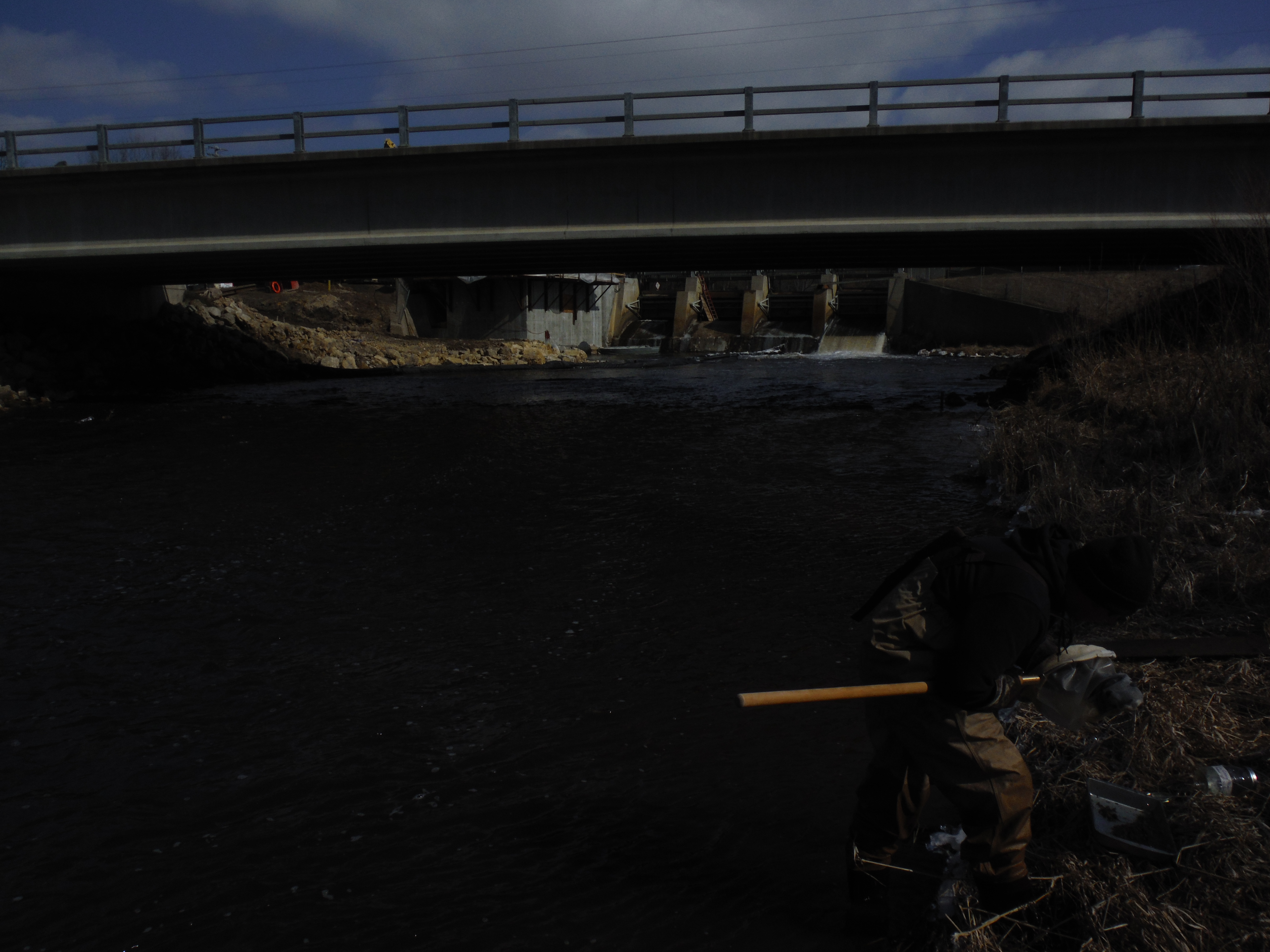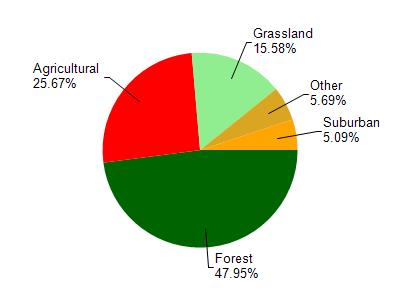
10.89 Miles
29.30 - 40.19
Warm Mainstem, Macroinvertebrate, COOL-Warm Mainstem
2024
Poor
Impairment Unknown
Total Phosphorus
La Crosse, Monroe
No
No
Yes
Fish and Aquatic Life
Overview
Approximately 23 miles of the La Crosse River flows through the heart of the Little La Crosse River Watershed. All streams in the Little La Crosse River Watershed ultimately drain to this middle portion of the La Crosse River. Many acres of wetland are found adjacent to the La Crosse. The uppermost 17.9 miles of the La Crosse River down to the dam at Perch Lake in Sparta flow through the Upper La Crosse River Watershed. The river originates just east of the Fort McCoy eastern border.
Date 2011
Author Aquatic Biologist
Overview
The La Crosse River flows in a southwesterly direction for approximately 64 miles through Monroe and La Crosse Counties before reaching the Mississippi River at Riverside Park in the City of La Crosse. The river drains approximately 500 square miles of forested and agricultural land. Five dams on the La Crosse River create Lake Neshonoc in West Salem, Perch Lake in Sparta, Angelo Pond in the Town of Angelo, and Alderwood Lake and Hazel Dell Pond both of which lie within the Fort McCoy Military Reservation. All five impoundments are used for recreational purposes; however, the dams at Lake Neshonoc and Perch Lake also generate hydroelectric power.
The La Crosse River is classified as a warmwater sport fishery from its mouth upstream to Rockland. The river then gradually becomes colder and is capable of holding trout. From Rockland upstream to the confluence of Squaw Creek in Fort McCoy, the La Crosse River is a Class II trout stream. Upstream of Squaw Creek, the river is considered Class I.
Date 2002
Author Aquatic Biologist
Impaired Waters
La Crosse River, from its mouth to Neshonoc Lake (miles 0 to 17.84), was evaluated every two-year cycle from 2012 to 2022; phosphorus was found to be too high in the 2012 cycle and this was confirmed in subsequent assessments. Chloride, bug, and fish data indicated good conditions.
La Crosse River, from Neshonoc Lake to Fish Creek (miles 19.7 to 29.3), was evaluated every two-year cycle from 2012 to 2018; phosphorus was found to be too high in the 2012 cycle and this was confirmed in subsequent assessments. Biology and chloride data showed no additional impairments.
La Crosse River, from Fish Creek to Perch Lake (miles 29.3 to 40.19), was evaluated for phosphorus and biology every two years from 2012 to 2018. In 2018 chloride was also evaluated. Phosphorus levels were found to be too high for healthy plant, bug, and fish communities, though fish were found to be in good condition.
La Crosse River, from Perch Lake to Anglo Pond (miles 40.75 to 43.23), has not been evaluated for water quality.
La Crosse River, from Angelo Pond to Suukjak Sep Creek (miles 43.94 to 49.72), was evaluated in 2014 and phosphorus showed no impairment.
La Crosse River, from Suukjak Sep Creek to headwaters (miles 49.72 to 61.94), was evaluated in 2014 for phosphorus and for biology in 2018; neither showed no impairment.
Date 2022
Author Ashley Beranek
Condition
Wisconsin has over 84,000 miles of streams, 15,000 lakes and milllions of acres of wetlands. Assessing the condition of this vast amount of water is challenging. The state's water monitoring program uses a media-based, cross-program approach to analyze water condition. An updated monitoring strategy (2015-2020) is now available. Compliance with Clean Water Act fishable, swimmable standards are located in the Executive Summary of Water Condition in 2018. See also the 'monitoring and projects' tab.
Reports
Recommendations
Monitor or Propose 303(d) Listing
La Crosse proposes to monitor one lake (impoundment) in 2012 that is currently on the 303d list. Data collection will include collecting Total Phosphorus (TP) and Chlorophyll a (Chl a) samples and documenting the vertical dissolved oxygen and temperature profiles. The monitoring activites are proposed for Lake Neshonoc located in La Crosse County.
Sewer Service Area Planning
The La Crosse Sewer Service Area Water Quality Management Plan 2013 - 2035 ("the Sewer Service Area Plan") is an update to the La Crosse Sewer Service Area Water Quality Management Plan 1999- 2020 which was completed in 1999 by the Mississippi River Regional Planning Commission, with input from the Department of Natural Resources, the La Crosse Area Planning Committee and the La Crosse Area Planning Committee's Technical Advisory Committee (TAC).
Management Goals
Wisconsin's Water Quality Standards provide qualitative and quantitative goals for waters that are protective of Fishable, Swimmable conditions [Learn more]. Waters that do not meet water quality standards are considered impaired and restoration actions are planned and carried out until the water is once again fishable and swimmable
Management goals can include creation or implementation of a Total Maximum Daily Load analysis, a Nine Key Element Plan, or other restoration work, education and outreach and more. If specific recommendations exist for this water, they will be displayed below online.
Monitoring
Monitoring the condition of a river, stream, or lake includes gathering physical, chemical, biological, and habitat data. Comprehensive studies often gather all these parameters in great detail, while lighter assessment events will involve sampling physical, chemical and biological data such as macroinvertebrates. Aquatic macroinvertebrates and fish communities integrate watershed or catchment condition, providing great insight into overall ecosystem health. Chemical and habitat parameters tell researchers more about human induced problems including contaminated runoff, point source dischargers, or habitat issues that foster or limit the potential of aquatic communities to thrive in a given area. Wisconsin's Water Monitoring Strategy was recenty updated.
Grants and Management Projects
Monitoring Projects
| WBIC | Official Waterbody Name | Station ID | Station Name | Earliest Fieldwork Date | Latest Fieldwork Date | View Station | View Data |
|---|
| 1650200 | La Crosse River | 423221 | La Crosse River ~300 ft US of S Court St at Sparta WI | 5/22/2002 | 10/15/2002 | Map | Data |
| 1650200 | La Crosse River | 10014283 | La Crosse River Station 5 - 500ft Below Mouth Of Beaver Creek | 10/13/2003 | 10/13/2003 | Map | Data |
| 1650200 | La Crosse River | 10014059 | La Crosse River Station 2 - 300ft Upstream Of The Cth J (Y?)Bridge Crossing - Downstream | | | Map | Data |
| 1650200 | La Crosse River | 10039620 | La Cross River at Amundsun Park | | | Map | Data |
| 1650200 | La Crosse River | 10056155 | La Crosse River below Perch Lake | 4/19/2022 | 10/16/2024 | Map | Data |
| 1650200 | La Crosse River | 10014284 | La Crosse River Station 1 - Garden Club Park In Sparta | | | Map | Data |
| 1650200 | La Crosse River | 423009 | La Crosse River - Above Sparta Stp At Hwy 16 | 7/5/1988 | 10/19/2002 | Map | Data |
| 1650200 | La Crosse River | 323005 | La Crosse River at Cth J | 5/14/2013 | 1/1/2015 | Map | Data |
| 1650200 | La Crosse River | 10011370 | La Crosse River - La Crosse River Station 1-B Perch Railroad Bridge Below Perch Lake | | | Map | Data |
| 1650200 | La Crosse River | 10014080 | La Crosse River Station 2 - Icarus Rd. Bridge Crossing - Downstream | | | Map | Data |
| 1650200 | La Crosse River | 423230 | La Crosse River at S Court Street | | | Map | Data |
| 1650200 | La Crosse River | 423011 | La Crosse River - Northern Engraving Sparta | 4/4/1978 | 11/13/1981 | Map | Data |
| 1650200 | La Crosse River | 10014060 | La Crosse River Station 3 - 150 Ft Downstream Of Hammer Rd. Bridge Crossing | 7/6/2004 | 7/6/2004 | Map | Data |
| 1650200 | La Crosse River | 423012 | La Crosse River at Sth 27 | 1/25/1995 | 1/25/1995 | Map | Data |
| 1650200 | La Crosse River | 423083 | La Crosse River - 2mi Below Sparta Stp | 7/5/1988 | 4/10/1989 | Map | Data |
| 1650200 | La Crosse River | 423010 | La Crosse River - Sparta Stp | 6/14/1967 | 7/26/1983 | Map | Data |
|

Watershed Characteristics
La Crosse River is located in the Little La Crosse River watershed which is 240.79 mi². Land use in the watershed is primarily forest (48%), agricultural (25.70%) and a mix of grassland (15.60%) and other uses (10.80%). This watershed has 445.88 stream miles, 114.59 lake acres and 5,439.88 wetland acres.
Nonpoint Source Characteristics
This watershed is ranked High for runoff impacts on streams, Not Ranked for runoff impacts on lakes and Low for runoff impacts on groundwater and therefore has an overall rank of Low. This value can be used in ranking the watershed or individual waterbodies for grant funding under state and county programs.However, all waters are affected by diffuse pollutant sources regardless of initial water quality. Applications for specific runoff projects under state or county grant programs may be pursued. For more information, go to surface water program grants.
La Crosse River is considered a Warm Mainstem, Macroinvertebrate, COOL-Warm Mainstem under the state's Natural Community Determinations.
Natural communities (stream and lake natural communities) represent model results and DNR staff valiation processes that confirm or update predicted conditions based on flow and temperature modeling from historic and current landscape features and related variables. Predicated flow and temperatures for waters are associated predicated fish assemblages (communities). Biologists evaluate the model results against current survey data to determine if the modeled results are corect and whether biological indicators show water quaity degradation. This analysis is a core component of the state's resource management framework. Wisconsin's Riverine Natural Communities.
Warm Mainstem waters are moderate-to-large but still wadeable perennial streams with relatively warm summer temperatures. Coldwater fishes are absent, transitional fishes are common to uncommon, and warm water fishes are abundant to common. Headwater species are common to absent, mainstem species are abundant to common, and river species are common to absent.